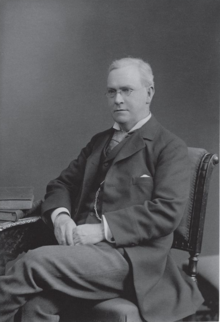
Back هوراس لامب Arabic هوراس لامب ARZ هوراس لمب AZB Horace Lamb Catalan Horace Lamb German Horace Lamb Spanish هوراس لمب Persian Horace Lamb French Horace Lamb HT Horace Lamb Italian
Horace Lamb | |
|---|---|
 Horace Lamb in 1885 | |
| Born | 27 November 1849 |
| Died | 4 December 1934 (aged 85) Cambridge, England |
| Nationality | British |
| Alma mater | Trinity College, Cambridge |
| Known for | Lamb vector Lamb–Oseen vortex Lamb–Chaplygin dipole Lamb waves Lamb surfaces Skin effect Volume viscosity |
| Awards | Smith's Prize (1872) Royal Medal (1902) De Morgan Medal (1911) Copley Medal (1923) |
| Scientific career | |
| Fields | |
| Institutions | |
| Academic advisors | James Clerk Maxwell[1] George Gabriel Stokes[2] |
| Signature | |
 | |
Sir Horace Lamb FRS[3] (27 November 1849 – 4 December 1934[4]) was a British applied mathematician and author of several influential texts on classical physics, among them Hydrodynamics (1895) and Dynamical Theory of Sound (1910).[5] Both of these books remain in print. The word vorticity was invented by Lamb in 1916.[6]
- ^ Andrew Warwick, Masters of Theory: Cambridge and the Rise of Mathematical Physics, University of Chicago Press, 2003, p. 325.
- ^ Horace Lamb at the Mathematics Genealogy Project
- ^ Love, A. E. H.; Glazebrook, R. T. (1935). "Sir Horace Lamb. 1849–1934". Obituary Notices of Fellows of the Royal Society. 1 (4): 374. doi:10.1098/rsbm.1935.0003.
- ^ R. B. Potts, 'Lamb, Sir Horace (1849–1934)', Australian Dictionary of Biography, Volume 5, MUP, 1974, pp 54–55. Retrieved 5 Sep 2009
- ^ O'Connor, John J.; Robertson, Edmund F. "Horace Lamb". MacTutor History of Mathematics Archive. University of St Andrews.
- ^ Truesdell, C. (1954). The kinematics of vorticity (Vol. 954). Bloomington: Indiana University Press.
© MMXXIII Rich X Search. We shall prevail. All rights reserved. Rich X Search